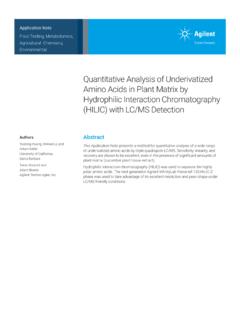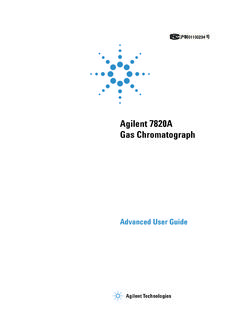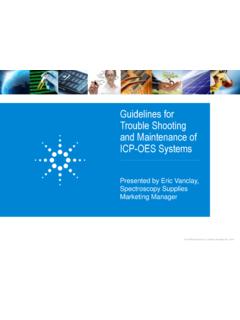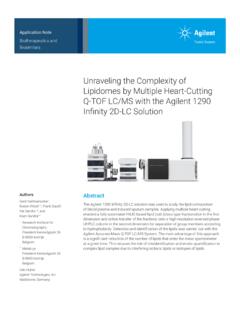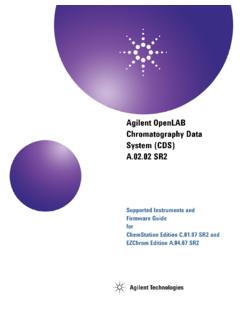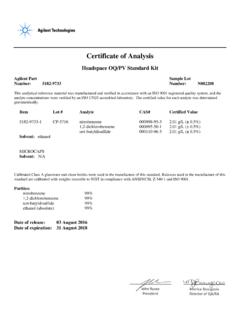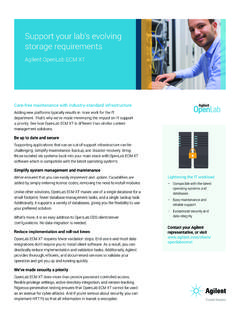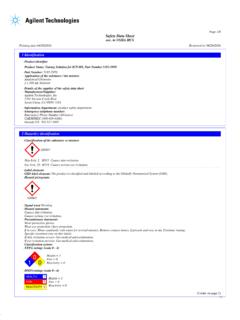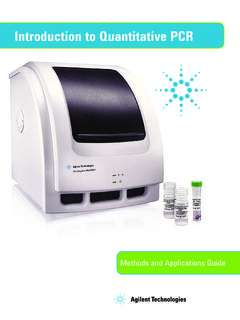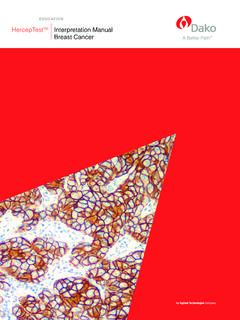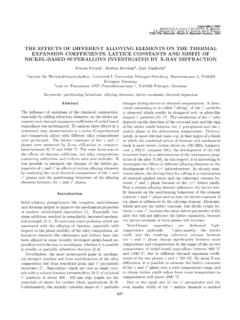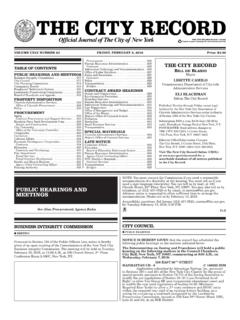Transcription of High-resolution Analysis of Charge Heterogeneity in ...
1 High-resolution Analysis of Charge Heterogeneity in monoclonal antibodies using pH-gradient Cation Exchange ChromatographyAgilent 1260 Infinity Bio-inert Quaternary LC System with Agilent Bio ColumnsApplication NoteBiopharmaceuticals, BiotherapeuticsAbstractAntibody Charge variants have gained considerable attention in the biotechnology industry due to their potential influence on stability and biological activity. Subtle differences in the relative proportions of Charge variants are often observed during routine manufacture or process changes and pose a challenge when demonstrat-ing product comparability. These changes include differences in glycosylation, deamidation, oxidation, isomerization, incomplete C-terminal processing, and other post-transitional modifications that modify the isoelectric pH (pI) values.
2 In the biotechnology industry, ion-exchange chromatography is widely used for profiling the Charge Heterogeneity of proteins, including monoclonal antibodies . This Application Note describes a High-resolution , pH-based separation of acidic and basic Charge variants for monoclonal antibodies using the Agilent 1260 Infinity Bio-inert Quaternary LC System and an Agilent BiomAb PEEK 250 mm, 5- m ion exchange column that features a unique resin specifically designed for the Charge -based separation of mAbs. The robustness of the method for routine Analysis was established by validation Sundaram Palaniswamy Agilent Technologies, , IndiaAcidic variants Basic variants Main peak2 IntroductionMonoclonal antibodies (mAb) are gly-coproteins of the immunoglobulin (Ig) family.
3 MAbs have become the most rapidly growing class of biotherapeu-tics in the development for many dif-ferent disease conditions. Novel mAb molecules are entering clinical studies at a rate of almost 40 per year, and the research pipeline includes approxi-mately 250 therapeutic mAbs in clinical studies. There is steadily increasing need for an analytical method that can be used for high-throughput Analysis of a large number of samples to support bioprocesses and formulation develop-ment. Biotherapeutics, such as mAbs, are complex molecules, and a variety of methods is required to monitor the heterogeneities associated with the mAb to ensure product quality and Cation exchange chro-matography is the gold standard for Charge -sensitive antibody Analysis .
4 In cation exchange chromatography, method parameters often need to be optimized for each individual protein as ion exchange is dependent on the reversible adsorption of the charged protein molecules to immobilized ion exchange groups. Several authors have made significant progress in demon-strating practical separations using pH changes in the mobile phase to elute the The Agilent ion exchange column family offers strong cation exchange (SCX), weak cation exchange (WCX), strong anion exchange (SA X) and weak anion exchange (WAX). The Agilent Bio MAb NP 5 (nonporous, 5- m) PEEK, 250 mm, column is specifically designed to characterize the Charge Heterogeneity of monoclo-nal antibodies , including C-terminal lysine variance.
5 The column offers even higher resolution , enabling better peak identification and accurate quantifica-tion. This Application Note describes a pH gradient based method for separat-ing the Charge variants of IgG1 using a 1260 Infinity Bio-inert Quaternary LC System and a Bio MAb NP 5 PEEK, 250 mm, ion exchange column. Method validation and robustness of an optimized ion exchange method are described. EquipmentInstrumentationA completely biocompatible Agilent 1260 Infinity Bio-inert Quaternary LC System operating up to a maximum pressure of 600 bar was used for the experiments (Table 1). The entire sample flow path is free of any metal components so that the sample does not come in contact with metal sur-faces.
6 Solvent delivery is free of any stainless steel or iron numberAgilent 1260 Infinity Bio-inert Quaternary PumpG5611 AAgilent 1260 Infinity Bio-inert High Performance AutosamplerG5667 AAgilent 1290 Infinity Thermostat (for autosampler)G1330 BAgilent 1260 Infinity Thermostatted Column Compartment with bio-inert click-in heating elements (option 019)G1316 CAgilent 1260 Infinity Diode Array Detector with 60-mm Max-Light high sensitivity flow cell (option 033)G4212 BTable 1 Configuration of the Agilent 1260 Infinity Bio-inert Quaternary LC preparation for the subsequent Analysis . Relative percent area was used to quantify the Charge variants of monoclonal StudyThe four critical method parameters listed below were varied to validate the IEX procedure.
7 Variation of injection volume ( 10%) Variation of buffer pH ( ) Variation of flow rate ( 2%) Variation of column temperature ( 5%)For each robustness parameter, 10 L of IgG1 was injected six times to calcu-late average area and RT. The percent-age deviation (% accuracy) of area and retention time (RT) was calculated from the optimized phase A was 10 mM sodium phosphate, pH and mobile phase B was 10 mM sodium phosphate, pH monoclonal antibodies were diluted to approximately 2 mg/mL in mobile phase A and elution was monitored at 220 nm and 280 nm. Area and retention time (RT) were used to calculate stand-ard deviation (SD) and relative standard deviation (%RSD).
8 For each elution, the column was pre-equilibrated with at least three column volumes of mobile phase A prior to sample injection. After the injection of the monoclonal anti-body sample onto the column, a linear increase in the percentage of mobile phase B was delivered. The linear gradients were run from 0 to 100% B in 27 minutes at 1 mL/min flow rate. After the gradient, the mobile phase was pumped at 100% B until at least one column volume passed before the composition was returned to 100% A SoftwareAgilent OpenL AB CDS ChemStation Edition, revision Exchange Chromatography ParametersTable 2 shows the Chromatographic parameters for Ion Exchange Chromatography using Agilent 1260 Infinity Bio-inert LC , samples and materialsHuman monoclonal antibody IgG1 was a proprietary pharmaceutical molecule.
9 Sodium phosphate dibasic dihydrate, sodium phosphate monoba-sic dihydrate, sodium chloride, sodium bicarbonate hydrochloric acid (HCl), and sodium hydroxide (NaOH) were purchased from Sigma Aldrich. All the chemicals and solvents used were HPLC grade and high purity water from Milli Q water purification system (Millipore Elix 10 model, USA) was used. Table 2 Chromatographic parameters used for IEX :Agilent Bio MAb PEEK, 250 mm, 5 m column (p/n 5190-2407)Mobile phase A:10 mM sodium phosphate buffer, pH phase B:10 mM sodium bicarbonate buffer, pH :Time (min)Mobile phase (% B)0 minutes0% B25 minutes100% B27 minutes100% B30 minutes0% BInjection volume:10 L (needle with wash, flush port active for 7 seconds)Flow mL/minData acquisition:214 and 280 nmAcquisition rate:20 HzFlow cell:60-mm pathColumn temperature:30 CSample thermostat:5 CPost time.
10 5 minutes4 Results and DiscussionSeparation and detectionThe Agilent Bio MAb columns are highly uniform, densely packed, weak cation exchange resin. This Application Note used the 5- m column that features a unique resin specifically designed for High-resolution Charge -based separations of monoclonal anti-bodies. The peaks of the ion exchange profiles were typically denoted into three distinct components3. Early and late-eluting peaks were called acidic and basic variants, respectively. The most abundant peak was designated as the main peak. Figure 1 shows the opti-mized cation exchange elution profile of IgG1 on Bio MAb PEEK column demonstrating excellent separation of IgG1 in 30 minutes into three distinct peaks: basic variants, main peak, and acidic variants.
